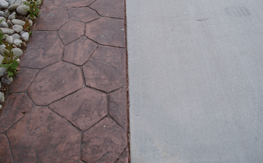Permeable paving joins a variety of surfacing strategies for roads, stopping regions, and bystander walkways, united under the common goal to consider intrusion of stormwater overflow. Vulnerable black-top surfaces consistently fuse pervious concrete, porous dark top, clearing stones and interlocking pavers. Rather than standard invulnerable clearing materials, permeable clearing systems license stormwater to penetrate and attack through the black-top and into the absolute layers just as the soil under. Just as diminishing surface flood, vulnerable clearing systems can trap suspended solids, thus filtering poisons from stormwater. The goal is to control stormwater at the source, decline flood and further foster water quality by isolating defilements in the subsurface layers.
Stormwater streams into and is taken care of in an essential stone storehouse. Vulnerable local driveway pavers are normally used on roads, ways and stopping regions subject to light vehicular traffic, for instance, cycle-ways, organization or emergency access ways, road and air terminal shoulders, and private walkways and parking spaces.
Depiction and applications :

Vulnerable game plans can be established on penetrable dark top and generous surfaces, significant pavers (permeable interlocking considerable clearing structures – PICP), or polymer-based grass pavers, lattices and geocells. Porous black-tops, for instance, pervious concrete and pervious dark top are more equipped for urbanized areas that see more normal vehicular traffic, while significant pavers, organizations, and geocells are more equipped for light vehicular traffic, walker and cycling pathways, and flood parking structures. Past generous pavers license water to pervade and enter through the pavers and into the all-out layers and also soil underneath. Impervious significant pavers presented with adequate void space between each paver work correspondingly as previously considerable pavers as they enable stormwater to drain into the voids between each paver, either stacked up with coarse aggregate or vegetation, to a stone and also soil base layer for on the spot attack and filtering. Polymer-based grass systems or cell paver structures give load-bearing help to unpaved surfaces of rock or turf.
Grass pavers, plastic turf developing organizations (PRTG), and geocells (cell constrainment systems) are honeycombed 3D cross-section cell structures, made of slim walled HDPE plastic or other polymer compounds. These give grass support, ground change and rock upkeep. The 3D plan upholds infill and moves vertical weights from the surface, appropriating them over a more broad district. Assurance of the sort of cell network depends to a degree on a shallow level material, traffic and loads. The cell networks are presented on a setup base layer of open-assessed stone (higher void isolating) or planned stone (more grounded). The surface layer may be compacted rock or soil developed with grass and fertilizer. In any caseload support, the cell network decreases compaction of the soil to stay aware of the vulnerability, while the roots further foster permeability as a result of their root channels.
In new country improvement, porous black-tops secure watersheds by conceding and filtering the flood stream. In existing created locales and towns, redevelopment and amusement are opportunities to execute stormwater water the chiefs practices. The vulnerable clearing is a critical part in Low Impact Development (LID), cooperation for land improvement in the United States that undertakes to restrict impacts on water quality and the equivalent thought of viable waste systems (SuDS) in the United Kingdom.
